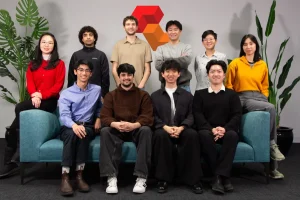AI’s Race for Chips OpenAI’s Bold Moves

AI is racing forward, and OpenAI is right in the heat. They’re getting ready to create their first AI chip by 2026. This move, backed by TSMC and Broadcom, shakes up the tech world.
OpenAI’s reliance on NVIDIA is changing. Their new collaboration hopes to optimize AI training with advanced chip designs. As demand soars, AI’s growth hinges on unique solutions.
OpenAI’s Chip Ambitions
OpenAI is diving into chip design, aiming for a 2026 launch. Partnered with TSMC and Broadcom, they’re crafting specialized chips. This focus on in-house technology marks a significant shift. For now, they’ve paused plans for a chip factory network, opting to enhance AI model training instead.
With growing AI demands, OpenAI is shifting from NVIDIA to collaboration with AMD and Broadcom. Their chips are expected to revolutionize AI capabilities by strengthening computation power.
OpenAI’s strategy to boost AI strength through these partnerships may reshape tech landscapes. The 2026 timeline suggests leaps in how AI processes data, making future tech predictions quite exciting.
The Importance of Computation Power
Computation power is a key AI driver. AI’s capabilities expand as processing power increases. OpenAI’s move into custom chip creation suggests this need is critical.
Demand for NVIDIA’s chips is skyrocketing. Companies can’t afford lagging in AI model training. Firms like Meta, Microsoft, Google, and Amazon are in fierce competition. The next wave of AI development demands reliable tech resources.
OpenAI’s potential success with special chips might redefine AI’s growth. They hope to minimize reliance on external tech and optimize their AI models. By honing in on efficient computing solutions, OpenAI positions itself as a leader in the field.
Racing Towards AGI
AI isn’t just a fad; it’s gearing towards AGI – something more.
Companies are vying for computing supremacy to lead in creating AGI. OpenAI’s chip endeavor reflects this global tech race for future AI.
The idea of AGI spurs companies to innovate fast. Having a strong computational base could divide leaders from followers.
As AGI approaches reality, companies sprint to prepare their infrastructure. It’s a high-stakes race where custom AI chips could be pivotal.
Reports suggest that AGI might arrive sooner than expected, even shocking skeptics. AI’s future feels both thrilling and daunting.
Current Challenges in AI
A significant hurdle in AI is the scarcity of NVIDIA chips.
This shortage impacts product development timelines, affecting giants like Meta and others. They face challenges meeting current AI demands due to this scarcity.
OpenAI’s strategic pivot to chip creation aims to overcome such setbacks. By reducing dependence on external suppliers, they target steadier development.
AI’s rapid evolution also tests global infrastructure. Meeting energy needs for data centers is crucial, particularly for maintaining computational efficiency.
With increasing demand for tech talent, countries race to secure AI capabilities. Strengthening and expanding resources becomes a national priority.
The Global Computing Arms Race
Countries are racing to dominate AI technology. National security is tied to technological prowess.
The U.S. is urged to expand energy infrastructure to support AI data centers. This global competition drives innovation and resource allocation.
Investment in clean energy and tech infrastructure is vital for leading the AI charge. Falling behind could have significant repercussions.
American companies prioritize establishing cutting-edge data centers. Meanwhile, other nations marshal resources for AI advancement.
Ensuring a consistent supply of powerful chips and energy is key to maintaining a competitive edge.
The Humane Side of Rapid AI Advances
Advances in AI feel thrilling yet daunting. There’s a sense of urgency surrounding AI development as strategies rapidly evolve.
Experts like OpenAI’s research scientist express amazement at AI’s quick strides. Their comments echo concerns about balance between innovation and potential risks.
AGI’s potential to reshape industries raises questions. Balancing rapid progress with ethical standards becomes essential.
The ongoing developments will likely lead to unforeseen societal shifts. Maintaining thoughtful AI deployment strategies will be crucial.
AI’s rapid advancements promise new opportunities and challenges. The pace of change may overwhelm or fascinate.
Public Perception and AI Skepticism
Public perceptions of AI are mixed. Fascination coexists with fear.
Prominent voices warn that AI evolution might not align with reality. Concerns about use and ethical implementation remain.
AI is heavily marketed, yet some experts point out discrepancies between hype and actual progress.
Public skepticism often addresses AI’s potential impact and its broader implications.
The discourse around AI includes voices highlighting its transformative capacity and calling for tempered expectations.
Robotics: AI’s New Frontier
Robots are becoming alarmingly lifelike. Recent innovations push the boundaries of what’s possible.
Engineered robots exhibit realistic movements, revealing AI’s reach in robotics. Despite skepticism, these advancements are real and significant.
AI influences industries beyond tech with robotics advancements. The potential for change is vast and unpredictable.
Emerging companies showcase robots, hinting at future growth and technological integration. Their progress points to exciting potential transformations.
Developments in AI Platforms
GitHub introduces new AI models, revolutionizing coding ecosystems. Choices and flexibility in tools expand AI’s role in tech.
This shift offers developers options with models like CLA 3.5 Sonic and others, diversifying coding tools.
GitHub’s response includes making advanced tools more accessible, which could redefine programming. The tech landscape is evolving quickly due to these updates.
AI platforms, by offering more choices, enhance productivity and innovation. The changes might influence broader technological practices.
AI’s Future: A Balance of Hype and Reality
AI’s future is intriguing, oscillating between rapid advances and looming challenges.
Experts debate AI’s potential and what advancements truly mean. Some urge caution, predicting a longer trajectory before reaching AI’s ultimate goals.
While AI’s possibilities amaze, the reality requires careful navigation. The journey involves ensuring responsible development and addressing societal impacts.
AI’s role in shaping the future ensures its place as a significant topic of discussion. Balancing excitement with practical considerations remains essential.
AI’s future teems with both promise and caution. As technology evolves, OpenAI’s strides in chip-making underscore dynamic shifts. Staying informed in this thrilling race is crucial.







